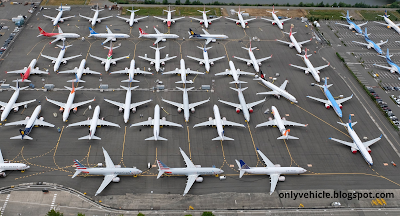Boeing 737 MAX tragedies
The Boeing 737 MAX is a modern narrow body aircraft designed to replace the older 737s and to compete with Airbus' a320 NEO. This type of competition is necessary and healthy, for two aircraft manufacturers. The problem arises when one of them rushes up its aircraft development to keep up for the other manufacturer's aircraft. In one previous post, we have discussed about how hurries lead to accidents. Check out the post by clicking the link here. It is the story of Pan Am flight 1736 and KLM flight 4509.
Coming back to our topic, the modern and advanced Boeing 737 MAX had faced two major tragedies from the start of its entry into service. The year 2018 was said to be the safest year to fly in airplanes. The same was expected till the end of the year and the following year. This all changed when Lion Air Boeing 737 MAX flight 610 plunged into the Java sea killing all occupants onboard. This incident was followed by the crash of Ethiopian Airlines Boeing 737 MAX flight 302 which plunged straight into the ground. One thing to assure from this is as follows. Despite all of this, air travel is still one of the most safest. Click the link here to view the post 'Air travel is the most safest'.
There is no safest time to fly nor there is a safest seat in an airplane.
Cause of the accidents:
Both of the above accidents had similar circumstances which led to similar outcomes. The popular and true cause of these accidents is the MCAS. MCAS stands for Maneuvering Characteristics Augmentation System. This system was installed in the plane by Boeing for a reason. They also did not inform airlines and pilots about this system. It was self functioning and did not need any sort of assistance except a certain datum. The need for this system arose because of an odd design feature of the Boeing 737 MAX aircraft. All of the technical information are discussed below.
Design of the Boeing 737 MAX:
The Boeing 737 MAX is not that tall from the ground. It has such a design because of a reason that dates back to history. Boeing intended the plane to be low to the ground so that baggage loading, and passenger boarding would be easier. This made the 737 aircraft popular among airlines as they have no need to spend money on stairs, and other equipment. The same design was kept up to this date. The 737 MAX should be designed to house two CFM International Leap-1B engines under its wings. These modern engines are massive and need a lot of space. As the engines wouldn't fit, Boeing designed the aircraft's wings to hold up the engines higher. This design posed a next problem.
As the engines were high towards the wing, on full power, tests showed that the aircraft violently pitched up. Boeing had to make up something for this unusual and dangerous phenomenon. This caused the MCAS to be developed.
MCAS:
The angle of the attack of an airplane is the angle with which the plane makes with the oncoming airflow towards it. Due to the design feature of the engines on the MAX, the angle of attack suddenly increases on full power. An angle of attack sensor was fixed on the plane and this sent messages to the flight computer. The flight computer then analyses the data and trims the aircraft automatically to counteract with the abnormal angle of attack. This is the complete working of the MCAS.
When will MCAS work?
There are some criteria which the aircraft should meet in order for it to activate MCAS. The criteria are shown as follows:
- The autopilot is turned off
- Wing flaps are extended
- Automatic trim is on
Boeing's advertisement:
Boeing advertised the Boeing 737 MAX, telling it that it did not require pilots to go through training from a scratch. Early 737 pilots could easily adapt to the new type. One simulator session was required and pilots could easily prepare. Boeing did not mention anywhere about MCAS. The airlines and not even the pilots knew anything about it.
Causes for the tragedies:
We know now that the MCAS receives data from the angle of attack sensor. It turns out that both of the aircraft involved in the tragedy had faulty positions of the angle of attack sensors. This caused wrong data to fed to the computer and MCAS was activated unnecessarily. As the pilots were not informed about MCAS, they did not know how to handle the situation and could not do anything. After the event of the Lion Air crash, which occurred first, Boeing had talked about the MCAS. Everyone came to know about MCAS for the first time. As the pilots of Ethiopian Air flight had not been trained properly, they did not know how to handle the MCAS and the plane crashed.
Grounding and recertification:
Due to these accidents, all of the 737 MAX aircraft which were in service were grounded on March 18, 2019.
Two years later, the 737 MAX problems were finally solved. Everyone were made aware of MCAS which led to the issue. The 737 was recertified to fly on June, 2021.
Things to learn from the accident:
From all accidents, there is something that everyone should learn. It includes the aircraft manufacturer, pilots, passengers, and the common people.
This is a well written story saying that hurries always lead to accidents. Aircraft manufacturers should always validate their product before selling it to airlines and other customers.
Pilots who are trained to fly on the 737 MAX have undergone training especially on the MCAS to deal with abnormal situations safely.
Passengers need not worry as airlines and pilots have taken care of the problem. They must understand that air travel is safer than travelling by car.
Common people and the media should not spread out false news which makes people afraid to travel by airplanes. Air transport is one of the most important means of transport.








0 Comments